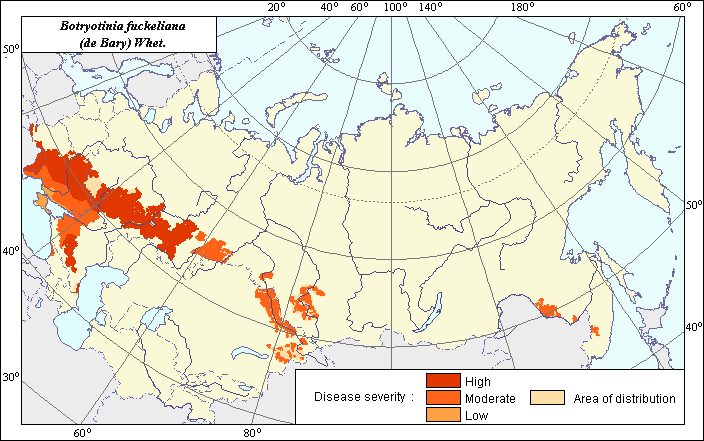Diseases
Area and disease severity zones of Botryotinia fuckeliana (de Bary) Whet.
 Object description Download GIS-layers
Object description Download GIS-layers
Authors:
Object specialist - V.I.Yakutkin, GIS-specialist - M.I.Saulich.Date of creation:
1.09.2003Scale:
1:20 000 000Accuracy of map:
It is created on information taken from the open-published literature and map of scale 1:40 000 000.Projection:
"Alber's Equal Area Conic for the USSR", 9, 1001, 7, 100, 0, 44, 68, 0, 0Basic content:
Vector map. Area of distribution and zones of disease severity are shown by polygons.Accuracy of the classifier:
Within the limits of sunflower area three zones of disease severity of B. fuckeliana are allocated. The first zone is a low disease severity, where yield losses do not exceed more than 10%. The second zone is a moderate disease severity, where the yield losses reach 30%. The third zone is a high disease severity, where the yield losses are more than 31%.Procedure of map drawing:
The area and disease severity zones were drawn on a blank map after analysis of published sources (Esimov , 1990; Tikhonov, 1975; Yakutkin et al., 1990; Yakutkin, 2001). Correction of the distribution and disease severity zones borders was carried out according to vector layer of sunflower distribution composed by I.E. Koroleva et al. (2003).The blank map with the image of the area and disease severity zones was scanned. A registration and vectoring of a raster map were carried out by standard tools of GIS-technologies.
Sources of the data:
De Bary A. 1866. Morphologie und Physiologie der Pilze, Flechten und Myxomyceten. Engelmann, Leipzig.Esimov A.D. 1990. Harmfulness of Gray Mould of Sunflower. Tezisy dokl. Respublikanskoi konferentsii, posvyashch. 60-letiyu Kazakhskogo selskokhozyaistvennogo instituta, Alma-Ata, p. 125-126 (in Russian).
Faretra F., Grindle M. 1992. Genetics studies of Botryotinia fuckeliana (Botrytis cinerea). Recent advances in Botrytis research. Proc. of the 10th International Botrytis Symposium, Heraklion, Crete, Greece, 5 -10 April 1992. Wageningen, p. 7-21.
Kukin V.F., Gavinskaya N.A. & Artemenko U.R. 1982. The short-term forecast of development of Gray Mould of Sunflower in the south of Ukraine. Nauchno-tekhnicheskii byul. Vsesoyuznogo selektsionnono-geneticheskogo instituta, 1, p. 43 (in Russian).
MacFarlane H.H. 1968. Plant host - pathogen index to volumes 1-40 (1922-1961). Review of Applied Mycology. Commonwealth Mycological Institute. Kew, 820 p.
Jarvis W.R. 1977. Botryotinia and Botrytis species: taxonomy, physiology and pathogenicity. Canada, 195 p.
Persoon C.H. 1801. Synopsis methodical fungorum. H.Dieterich, Gottingen.
Tikhonov O.I. 1975. Diseases of sunflower. In: Sunflower. Moscow, Kolos, p. 401-409 (in Russian).
Yakutkin V.I. & Milyutenkova T.I. 1990. Forecast of White Rot and Gray Mould of sunflower for optimization of the protective methods. The methodical recommendations. St.Petersburg, 17 pp. (in Russian).
Yakutkin V.I. & Milyutenkova T.I. 1991. The account, forecast of White Rot and Gray Mould of Sunflower. The methodical recommendations. St.Petersburg, 36 pp. (in Russian).
Yakutkin V.I. 2001. Diseases of sunflower in Russia and their control. Zashchita i karantin rastenii, N10, p. 26-29 (in Russian).

